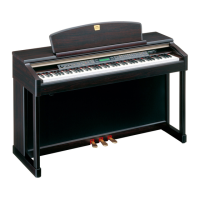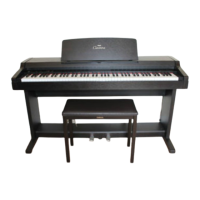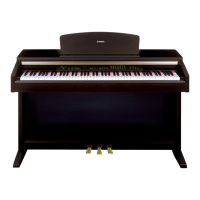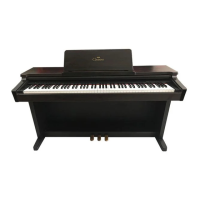Do you have a question about the Yamaha Clavinova CLP-156 and is the answer not in the manual?
Highlights main functionalities like stereo sampling, touch response, dual play, reverb, recorder, and MIDI.
Encourages thorough reading for full benefit and reference.
Covers cleaning, avoiding vinyl, care with force, and environmental conditions.
Rules for disk insertion, ejection, protection, and storage.
Describes POWER, VOLUME, BRILLIANCE, and REVERB controls.
Instructions for setting up and using the music stand.
Describes METRONOME, TEMPO buttons, and TEMPO display.
Covers SONG, RECORDER PLAY/REC, and track buttons.
Access to transpose functions and demo playback modes.
Mentions the 3.5" floppy disk drive and pedal controls.
AUX IN/OUT jacks for connecting external audio sources.
MIDI IN, THRU, and OUT ports for MIDI communication.
PHONES jack for private practice with headphones.
Initial steps for turning on the Clavinova and setting master volume.
Choosing instrument sounds and utilizing touch response.
Using BRILLIANCE and REVERB buttons to modify sound.
How to activate demo mode and choose specific demo songs.
Adjusting volume and stopping demo playback.
Adjusting the volume balance between two selected voices.
Adjusting voice pitch and selecting a slow-attack string sound.
Saving balance, octave, and string type settings.
Adjusting the tonality or 'timbre' of the selected voice.
Saving the selected brilliance preference.
Choosing from ROOM, HALL 1/2, and COSMIC reverb effects.
Controlling the intensity or depth of the selected reverb effect.
Saving the selected reverb type and depth settings.
Selecting HARD, MEDIUM, SOFT, or FIXED key response.
Saving the preferred touch sensitivity setting.
Describes the Soft, Sostenuto, and Damper pedals.
Adjusting the overall keyboard pitch up or down in semitones.
Fine-tuning individual keys by cents or hertz.
Resetting the keyboard pitch to the default concert standard.
Viewing the pitch value and saving custom pitch settings.
Turning on/off, adjusting volume, and setting time signature.
Setting the tempo for metronome, recording, and playback.
Inserting a disk and choosing songs for playback.
Controls for playback initiation, volume, and termination.
Safe removal of the disk from the drive.
Changing playback speed and using fast forward/reverse.
Playing specific tracks and looping playback.
Support for Standard MIDI Files and other disk types.
Inserting disk, selecting song, choosing voices and initial settings.
Record ready mode, track selection, metronome use, and starting record.
Ending recording and modifying initial settings after recording.
Deleting tracks and recording without a disk inserted.
Playing back recorded songs and muting tracks.
Adjusts the pitch of a single key downwards.
Adjusts the pitch of a single key upwards.
Choosing the 'Up-tuning' mode for pitch adjustment.
Adjusting keys and turning the tuning mode off or on.
Saves the current individual key tuning setup to a disk.
Reloads a saved individual key tuning setup from a disk.
Inserting a disk and engaging the format function.
Starting the disk formatting process.
Choosing the source song and destination for the copy.
Performing the song copy process.
Choosing the song and activating the delete function.
Finalizing the song deletion process.
Removes a single track from a recorded song.
Assigning disk tracks to CLP-156 playback tracks.
Converts performance data to SMF format.
Sets songs to play back in a random order.
Chooses between General MIDI or Normal voice assignments.
Basic concepts of Musical Instrument Digital Interface.
Details Note, Velocity, Program, and Control Change messages.
Configures the MIDI channels for transmitting and receiving data.
Transposes the pitch of MIDI data transmitted by the Clavinova.
Manages keyboard's internal sound response to MIDI.
Controls Program Change message transmission and reception.
Manages Control Change message handling for pedals and effects.
Enables independent control of Clavinova voices by external MIDI.
Splits keyboard and manages local control for external devices.
Assigns keyboard sections to internal or external tone generators.
Sends current Clavinova settings via MIDI OUT.
Restores all settings to original factory default values.
Lists and explains potential error codes.
Solves common operational problems like no sound or noise.
Unpacking parts and attaching feet to side panels.
Securing the rear panel to the stand assembly.
Placing and securing the keyboard unit onto the assembled stand.
Connecting the pedal cord and setting the stand adjuster.
Details the data format for MIDI Note On/Off messages.
Details the data format for MIDI Control Change messages.
Details the data format for MIDI Program Change messages.
Details system messages and Yamaha-specific MIDI data formats.
Details the data formats for panel settings.
Details data formats for tuning and name information.
Explains the meaning of product safety graphics and symbols.
Provides information on battery life, disposal, and environmental issues.
Covers service responsibility, modifications, and warranty.
Covers power, ventilation, temperature, wet locations, and accessories.
Addresses cord safety, servicing, and the risk of electric shock.
Warns about potential hearing damage from high volume levels.
Details FCC regulations, product compliance, and interference.
Provides instructions for wiring the mains lead in the UK.
| Brand | Yamaha |
|---|---|
| Model | Clavinova CLP-156 |
| Category | Musical Instrument |
| Language | English |












